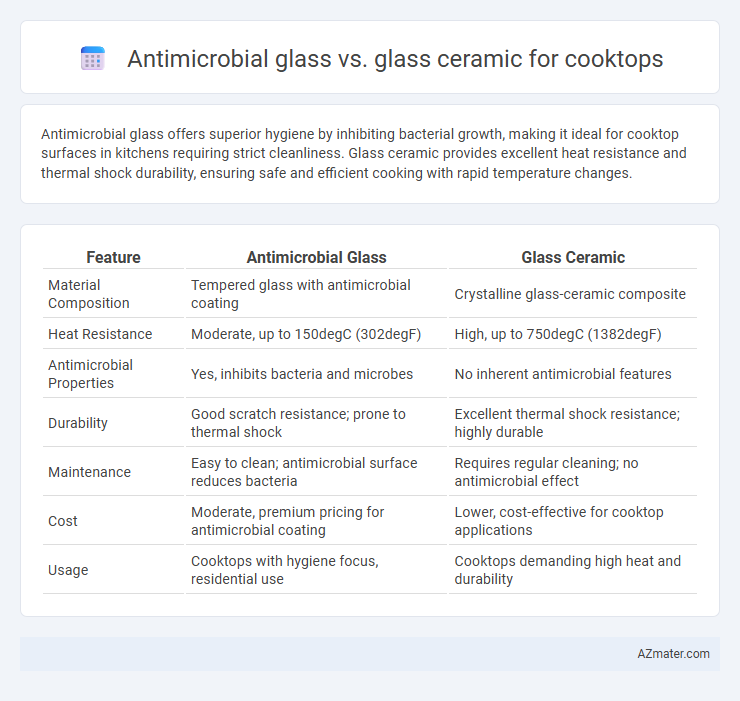Antimicrobial glass offers superior hygiene by inhibiting bacterial growth, making it ideal for cooktop surfaces in kitchens requiring strict cleanliness. Glass ceramic provides excellent heat resistance and thermal shock durability, ensuring safe and efficient cooking with rapid temperature changes.
Table of Comparison
| Feature | Antimicrobial Glass | Glass Ceramic |
|---|---|---|
| Material Composition | Tempered glass with antimicrobial coating | Crystalline glass-ceramic composite |
| Heat Resistance | Moderate, up to 150degC (302degF) | High, up to 750degC (1382degF) |
| Antimicrobial Properties | Yes, inhibits bacteria and microbes | No inherent antimicrobial features |
| Durability | Good scratch resistance; prone to thermal shock | Excellent thermal shock resistance; highly durable |
| Maintenance | Easy to clean; antimicrobial surface reduces bacteria | Requires regular cleaning; no antimicrobial effect |
| Cost | Moderate, premium pricing for antimicrobial coating | Lower, cost-effective for cooktop applications |
| Usage | Cooktops with hygiene focus, residential use | Cooktops demanding high heat and durability |
Introduction to Modern Cooktop Materials
Antimicrobial glass and glass-ceramic represent two advanced materials widely used in modern cooktops due to their durability and safety features. Antimicrobial glass incorporates agents that inhibit bacterial growth, enhancing hygiene in kitchen environments, while glass-ceramic offers superior thermal shock resistance and even heat distribution, essential for efficient cooking. Both materials contribute to the evolution of cooktop technology by combining functional performance with health-conscious innovations.
What is Antimicrobial Glass?
Antimicrobial glass is specially engineered with embedded agents like silver ions that inhibit the growth of bacteria and other microbes on its surface, enhancing hygiene and safety in kitchen environments. Unlike standard glass ceramics used in cooktops, which primarily offer heat resistance and durability, antimicrobial glass actively reduces microbial contamination. This property makes antimicrobial glass an ideal choice for cooktops in homes and commercial kitchens aiming to maintain cleaner, safer cooking surfaces.
Overview of Glass Ceramic Cooktops
Glass ceramic cooktops offer exceptional heat resistance and rapid temperature changes without cracking, making them ideal for efficient cooking. Their smooth, non-porous surface ensures easy cleaning and hygienic food preparation, while antimicrobial treatments on some models further inhibit bacterial growth. Compared to antimicrobial glass, glass ceramic cooktops combine durability with advanced thermal performance, enhancing both safety and user experience.
Key Differences: Antimicrobial Glass vs Glass Ceramic
Antimicrobial glass features a special coating that inhibits bacterial growth, enhancing kitchen hygiene, while glass ceramic offers superior heat resistance and thermal shock durability for cooktop surfaces. Glass ceramic typically withstands higher temperatures and rapid temperature changes better than antimicrobial glass, making it ideal for direct contact with high heat. The antimicrobial glass prioritizes cleanliness and safety, whereas glass ceramic focuses on performance and longevity under intense cooking conditions.
Durability and Resistance to Scratches
Antimicrobial glass used in cooktops offers enhanced durability due to its ability to resist microbial degradation while maintaining a smooth surface that minimizes bacteria buildup. Glass ceramic cooktops excel in scratch resistance because their crystalline structure provides superior hardness and thermal shock resistance, making them less prone to surface damage during heavy use. Comparing both, glass ceramic typically outperforms antimicrobial glass in scratch durability, whereas antimicrobial glass provides added hygienic benefits without compromising structural integrity.
Heat Distribution and Cooking Performance
Antimicrobial glass cooktops offer resistance to bacteria while providing moderate heat distribution suitable for everyday cooking, but glass ceramic cooktops excel in even heat distribution and rapid temperature changes, enhancing precise cooking performance. Glass ceramic surfaces feature low thermal expansion, reducing the risk of cracks under thermal stress, which ensures consistent heat flow across the cooking zone. The superior thermal conductivity of glass ceramic materials leads to faster heating and better energy efficiency compared to standard antimicrobial glass, making them ideal for advanced cooking techniques.
Hygiene and Ease of Cleaning
Antimicrobial glass for cooktops inhibits bacterial growth on the surface, enhancing hygiene by reducing harmful microorganisms. Glass ceramic offers a smooth, non-porous surface that resists stains and is easy to clean with minimal effort, often requiring only a damp cloth to maintain shine. Both materials contribute to a hygienic cooking environment, but antimicrobial glass provides an active defense against bacteria while glass ceramic excels in effortless surface maintenance.
Aesthetic Appeal and Design Options
Antimicrobial glass offers a sleek, modern aesthetic with a smooth, glossy surface that resists fingerprints and smudges, enhancing the cooktop's visual appeal and hygiene. Glass ceramic provides greater design versatility, including customizable colors, patterns, and textures, while maintaining heat resistance and durability that support creative cooktop layouts. Both materials complement contemporary kitchen designs but cater to different priorities: antimicrobial glass emphasizes cleanliness and minimalism, whereas glass ceramic focuses on personalized style and design flexibility.
Cost and Availability Comparison
Antimicrobial glass for cooktops typically incurs higher costs due to specialized coatings or treatments that inhibit bacterial growth, whereas glass ceramic remains more affordable and widely available because it is produced using established manufacturing processes. Availability of antimicrobial glass is limited, often found in premium or niche market segments, while glass ceramic cooktops are mainstream and accessible globally in multiple price ranges. Cost efficiency and broad distribution make glass ceramic a popular choice despite the added health benefits of antimicrobial glass.
Which Cooktop Material is Best for Your Kitchen?
Antimicrobial glass offers superior resistance to bacteria and easy cleaning, making it ideal for maintaining hygiene in kitchen cooktops, while glass ceramic provides excellent heat resistance and durability with rapid, even heat distribution. Glass ceramic surfaces excel in scratch and impact resistance, ensuring long-term durability under heavy use, whereas antimicrobial glass prioritizes hygienic properties without compromising transparency and smoothness. For kitchens prioritizing sanitation and frequent cleaning, antimicrobial glass is best, while glass ceramic suits those seeking high thermal efficiency and robust performance.

Infographic: Antimicrobial glass vs Glass ceramic for Cooktop
 azmater.com
azmater.com